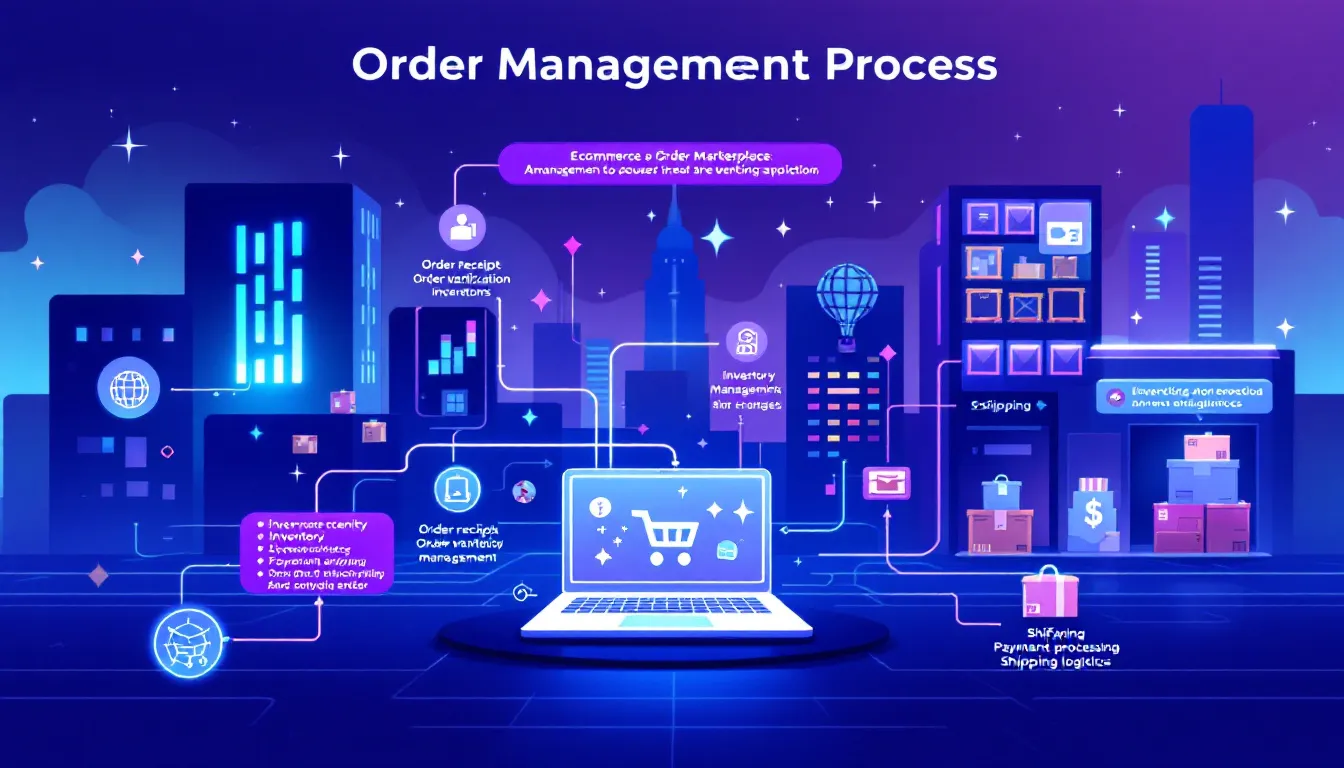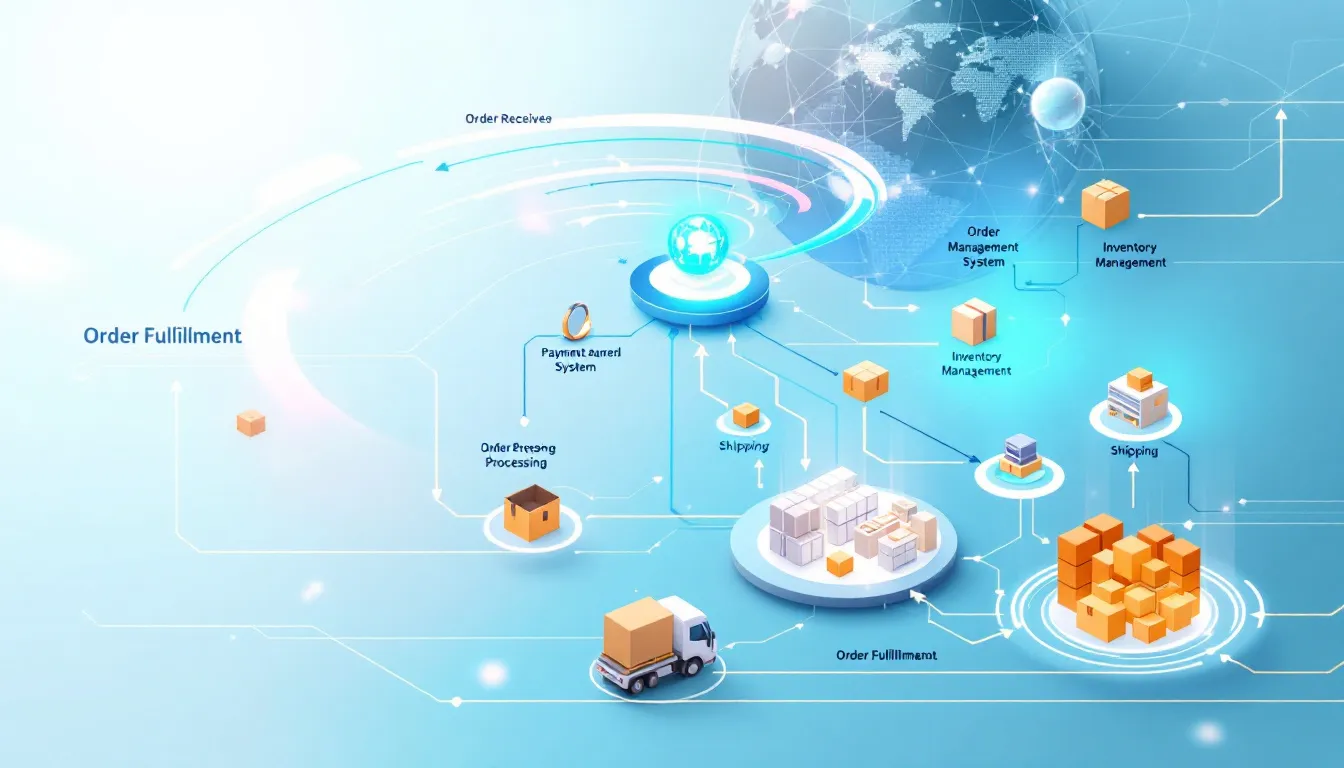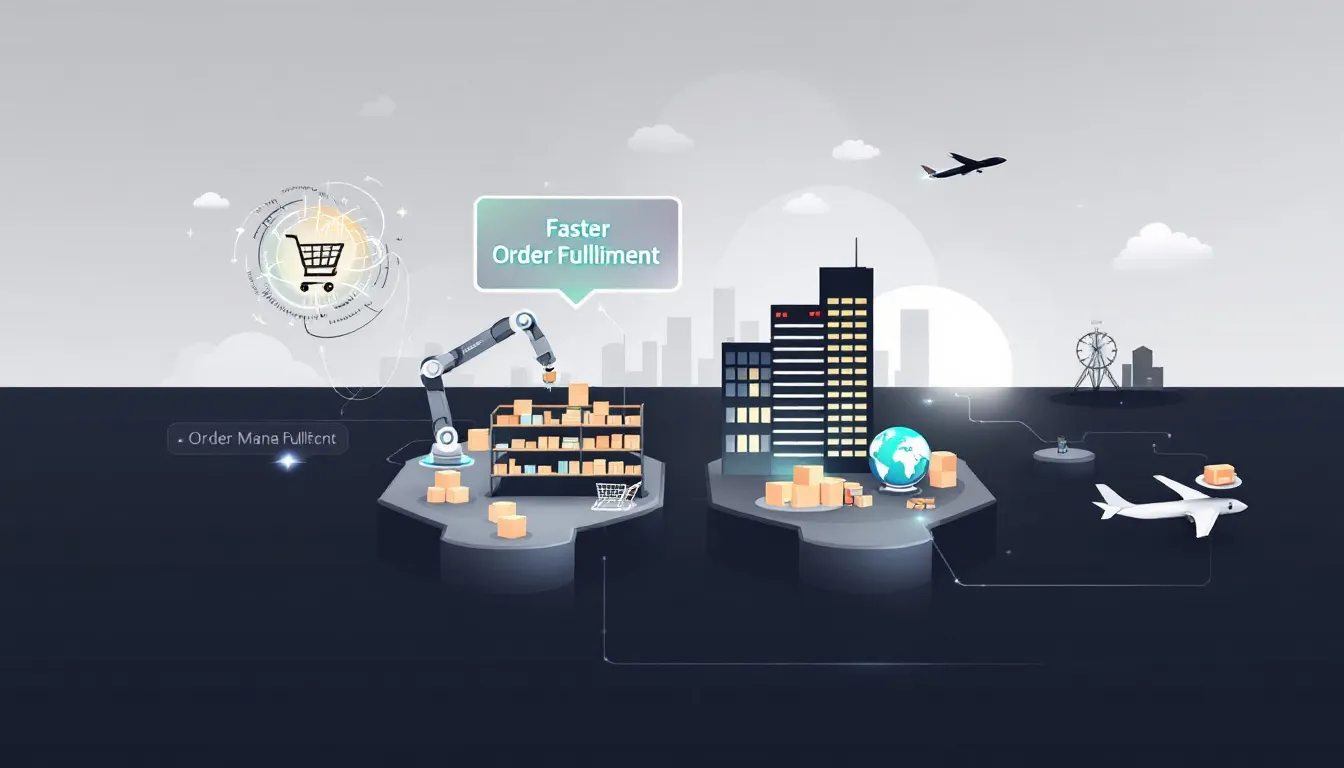Mastering Ecommerce Order Management: A Comprehensive Guide
15 Nov 2024
|by diadmin

Ecommerce order management involves tracking and managing orders from placement to delivery, ensuring smooth operations and customer satisfaction. This guide will cover its key aspects, benefits, and best practices to optimize your ecommerce workflow.
Key Takeaways
- Ecommerce order management is critical for business success, covering the entire order lifecycle from placement to delivery, and relies heavily on an effective order management system (OMS) for automation and efficiency.
- The core functions of an OMS include inventory management, order processing, and customer data management. These functions enhance operational efficiency and customer satisfaction by streamlining processes and reducing errors.
- Implementing an OMS provides significant benefits, such as faster order fulfilment, reduced human error, and cost savings. It also enables businesses to scale operations and improve the overall customer experience.
Ecommerce Order Management

Ecommerce order management is the lifeblood of any successful online store. It encompasses the entire journey of managing customer orders, from the moment they are placed to the final delivery. This process is essential for maintaining stock levels, reducing fulfilment errors, managing customer inquiries, and ensuring the smooth operation of your business.
An order management system (OMS) plays a pivotal role in this process. An OMS automates manual tasks, reducing errors, saving time, and improving overall efficiency. It tracks orders, inventory, and fulfilment, providing a consolidated view of all operations. This integration of data enhances visibility into the retail fulfilment process, ultimately improving customer satisfaction.
The lifecycle of ecommerce order management includes capturing order details, processing payments, managing inventory, and handling returns. It begins when a customer places an order and concludes when they receive their package. Effective order management solves problems by streamlining fulfilment, providing necessary data, and creating efficiencies that benefit both the business and its customers.
Core Functions of an Ecommerce Order Management System (OMS)
At the heart of efficient ecommerce operations lies the order management system (OMS), a powerful tool designed to consolidate and streamline various processes. An OMS performs several core functions that are essential for managing online orders effectively. These functions include inventory management, order processing, and customer data management.
Inventory management is a critical function of an OMS, ensuring that stock levels are accurately tracked and managed. By automating inventory updates and predicting safety stock needs, an OMS helps prevent overstocking and understocking, maintaining optimal inventory levels. This not only improves operational efficiency but also enhances customer satisfaction by ensuring product availability.
Order processing is another vital function of an OMS. It encompasses the workflow from order placement to delivery, including picking, sorting, tracking, and shipping of items. Automation plays a significant role in this process, reducing errors and speeding up fulfilment. Efficient order processing is crucial for meeting customer expectations and maintaining trust.
Customer data management is the third core function of an OMS. Centralizing customer data within the system facilitates better service and personalized marketing. Integrating customer relationship management (CRM) capabilities allows businesses to utilize customer data effectively, enhancing the overall customer experience.
Inventory Management
Inventory management is the backbone of an effective order management system. An OMS automatically issues purchase orders when inventory levels are low, preventing stockouts and ensuring that products are always available for customers. This proactive approach helps maintain a seamless flow of operations and reduces the risk of losing sales due to unavailable products, highlighting the importance of warehouse management.
The system also helps prevent overstocking and understocking by sending alerts for low or excessive stock levels. Tracking sales through various platforms, an OMS ensures accurate and up-to-date inventory management. Real-time inventory visibility is crucial for knowing stock levels, backorders, and restock timing, allowing businesses to make informed decisions.
An OMS streams all order and inventory data into a centralized system, improving visibility and operational efficiency. This centralized approach not only enhances inventory control but also provides valuable insights through reports and trend predictions. By preventing misjudgments in inventory amounts, an OMS ensures that businesses can meet customer demands effectively.
Order Processing
Order processing is the workflow that transforms an order placement into a delivered product. This process includes several essential steps: picking, sorting, tracking, and shipping of items. Once an order is placed, the information is communicated to the fulfilment location, where the order processing begins.
Automation in order processing plays a vital role in enhancing efficiency. An OMS automates the entire order fulfilment process, from order placement to shipping. This includes tasks such as calculating shipping costs, sending fulfilment requests, and updating order statuses. Automating these tasks reduces errors and speeds up the fulfilment process.
Accurate and reliable order processing is crucial for enhancing customer satisfaction. Timely updates and reliable tracking boost customer trust and provide a smoother customer experience. Automation in order processing not only improves efficiency but also ensures that customers receive their orders promptly and accurately, meeting their expectations.
Customer Data Management
Managing customer data is essential for providing personalized service and improving overall customer satisfaction. An OMS centralizes customer data, making it easily accessible for better service and marketing efforts. This centralized approach allows businesses to utilize customer information effectively, enhancing customer relationship management (CRM).
By recording order details and customer information, an OMS ensures that businesses have accurate data at their fingertips. This data can be used for personalized marketing, improving engagement, and providing a better customer experience.
Effective customer data management within an OMS is crucial for meeting customer expectations and fostering long-term relationships.
The Order Fulfillment Process

The order fulfillment process is a complex yet essential aspect of ecommerce operations. It involves managing orders from the moment they are placed until they are delivered to the customer and includes handling returns. Understanding and optimizing this process is key to ensuring customer satisfaction and operational efficiency.
A comprehensive view of the order management process allows businesses to identify real-time problems and address them promptly. The main steps in the order management process can be broken down into distinct phases: receiving orders, picking and packing, and shipping and delivery. Streamlining these steps can significantly reduce errors and delays within the order management system.
Effective order fulfilment is crucial for meeting modern shoppers’ expectations, who prioritize speed of delivery. An OMS assists in the fulfilment of orders. It does this by speeding up the filling process and enhancing accuracy. Real-time tracking capabilities provided by an OMS enhance the overall order fulfilment experience, ensuring that customers are informed about their orders at every stage.
Receiving Orders
Receiving orders is the first step in the order fulfilment process. Orders can be received through various channels, including websites, emails, and third-party sales sites. Customers place orders from different locations and times through these sales channels, making it essential to have a system that can handle this diversity.
Once an order is received, it is entered into the system for processing. The OMS monitors the status of orders. It also updates the fulfilment and delivery information in collaboration with connected shipping providers. Centralizing order information in a single system enhances tracking capabilities and improves communication with customers.
The OMS connects inventory management, the ecommerce platform, and the fulfillment team to streamline order processing. Integration with third-party logistics (3PL), Fulfilled by Amazon (FBA), or shipping carriers helps track shipped orders and provides real-time updates to customers. This integration ensures that orders are processed efficiently and accurately.
Picking and Packing
Picking and packing are critical steps in the order fulfilment process. After a customer order is placed, it is stored, selected, packaged, and shipped. The efficiency of the picking process is crucial to prevent delays and maintain customer satisfaction. In large warehouses, order picking can take considerably longer, making it essential to have an optimized process.
Modern OMS automates the picking, packing, and shipping processes of order fulfilment. Once an item is picked for an order, it is brought to the packing station for confirmation and packing. The packing process involves choosing appropriate packing material, weighing the package, and labelling it. Automation in picking and packing not only speeds up the process but also reduces errors.
ShipBob, for example, offers branded packaging and custom options like packing labels and marketing inserts. OMS can print necessary documents during the order fulfilment process, including packing slips and shipping labels. By integrating with third-party logistics, the OMS sends shipping information for order fulfilment, ensuring a smooth process.
Shipping and Delivery
Shipping and delivery are the final steps in the order fulfilment process. Shipping options can vary, and an OMS optimizes shipping routes to minimize costs and delivery times. Smart order routing helps in delivering products faster by optimizing delivery routes based on inventory location.
A shipment tracking number is assigned to each order, allowing customers to track their orders in real time. Customers are provided with this tracking number, which facilitates order tracking and enhances their experience. Transparency in order tracking and fulfilment processes helps prevent negative reviews and enhances customer satisfaction.
During order delivery, the carrier picks up the order and delivers it to the customer. The OMS updates the customer after sending order information to the fulfilment centre, ensuring that they are informed at every stage of the process. Providing tracking information and timely updates reduces uncertainty and boosts customer trust.
Benefits of Implementing an OMS in Ecommerce

Implementing an order management system (OMS) in ecommerce offers a myriad of benefits that can transform your business operations. A well-functioning order management process is crucial for ensuring customer satisfaction through timely deliveries. By automating customer inquiries and order processing, an OMS frees up time for other business activities, enhancing overall operational effectiveness.
An OMS centralizes and tracks data, inventory turnover, and order routing across multiple sales channels, simplifying complexity and ensuring accuracy. This centralization helps businesses scale efficiently, removing bottlenecks as the order volume increases. Regular audits and optimizations facilitated by an OMS ensure that data remains accurate and processes are efficient.
The goal of implementing an OMS is to reduce manual work, minimize human error, streamline data, and save on logistics costs. An efficient order management system is not only about managing orders but also about improving workflow, increasing customer retention, and ultimately driving more revenue.
Faster Order Fulfillment
An OMS significantly speeds up the order fulfilment process, ensuring that customer orders are processed and delivered swiftly. By checking stock across multiple locations and identifying the nearest fulfilment centre, an OMS streamlines the picking and packing process. This optimization not only reduces shipping times but also minimizes shipping costs.
Automated order management systems provide real-time updates on order progress, enhancing fulfilment speed and reducing the risk of delays. Customers appreciate being kept in the loop with live tracking information, which builds trust and reduces the need for them to contact customer support.
Preventing overstocking and understocking is another critical benefit of an OMS, ensuring product availability and maintaining profits. Faster order fulfilment leads to unmatched customer satisfaction, as customers receive their orders promptly and without issues.
Reduced Human Error
One of the most significant advantages of an OMS is the reduction of human error. Automation in an OMS removes manual processes, significantly minimizing the potential for mistakes in order processing. By automating and synchronizing workflows, an OMS ensures that order details are organized and accurate, further lowering the chances of errors.
As order volume increases, the risk of errors can also rise. However, an OMS utilizes automation and streamlined workflows to handle larger volumes efficiently, reducing fulfillment errors. This not only saves time and resources but also enhances operational efficiency and overall customer satisfaction.
Cost Savings
Implementing an OMS can lead to significant cost savings for ecommerce businesses. By streamlining and automating tasks, an OMS reduces operational costs and improves supply chain efficiency. This efficiency is crucial for enhancing the bottom line and ensuring that resources are utilized effectively.
Accurate inventory information provided by an OMS prevents overstocking and understocking, which can lead to high carrying costs and customer dissatisfaction. Additionally, an OMS integrates with shipping carriers and offers discounted shipping rates, helping to reduce shipping costs and improve delivery speed.
These cost savings contribute to a more profitable and sustainable business model.
Choosing the Right Order Management System for Your Business
Selecting the right order management system (OMS) for your ecommerce business is a critical decision that can impact your operations and growth. The goal is to find a system that aligns with your business needs and enhances your competitive edge. When choosing an OMS, consider factors such as pricing, the helpfulness of support teams, and the vendor’s expertise in the field.
An OMS is particularly beneficial for businesses that manage orders from multiple sales channels. It centralizes order management and simplifies complex processes, making it easier to handle high order volumes. Scalability is another essential factor, as the right OMS should be able to grow with your business and accommodate increasing demands.
Workflow automation and integration with existing platforms are critical considerations when selecting an OMS. A well-integrated system ensures seamless data flow, minimizing manual entry errors and enhancing overall efficiency.
Key Features to Look For
When evaluating different OMS options, certain key features should be prioritized. Integration capabilities with existing systems are crucial for seamless order management. Investing in integration with other business systems facilitates seamless data flow, minimizing manual entry errors and improving operational efficiency.
Scalability is another vital feature to look for in an OMS. A scalable system can accommodate increased order volumes as the business expands, ensuring that the OMS can grow alongside the business.
Ease of use is also important, as it ensures that employees can quickly adapt to the system and use it effectively.
Evaluating Vendors
Evaluating OMS vendors is a crucial step in choosing the right system for your business. Trial periods are important for assessing the functionality and compatibility of an OMS with your business needs. These trials allow you to test the system’s features and determine if it meets your requirements before committing.
Robust customer support is essential for successful implementation and ongoing usage of the OMS. Ensure that the vendor offers comprehensive support and training to help your team get the most out of the system. Considering both trial periods and customer support as critical factors will help you make an informed decision and choose a vendor that best fits your business.
Overcoming Common Challenges in Ecommerce Order Management
Ecommerce businesses face several challenges in order management, including fulfilment complexity, consolidating orders, and managing returns. Without an OMS, these challenges can lead to manual errors, increased returns, logistical issues, and higher operational costs. Overcoming these challenges is essential for maintaining efficient operations and customer satisfaction.
Delays in order processing can inflate operational costs and negatively impact customer relationships. An effective OMS addresses these challenges by automating processes, centralizing data, and improving overall efficiency. By leveraging the capabilities of an OMS, businesses can streamline their operations and overcome common hurdles.
Integration Issues
Integration issues can arise when implementing an OMS, particularly if existing systems are outdated. Outdated technology may hinder the smooth integration of the OMS with other platforms, leading to delays and information errors. Poor integration can significantly affect customer service and order accuracy, diminishing operational efficiency.
The consequences of integration issues include diminished operational efficiency, errors in order processing, and dissatisfied customers. To overcome these challenges, it’s crucial to ensure that the OMS is compatible with your existing systems and that any integration issues are addressed promptly.
Scalability Concerns
As an ecommerce business grows, scalability concerns can become a significant challenge. Increased sales, more channels, expanded inventory, and a larger customer base all require scalable technology to manage effectively. Business growth can reveal scalability issues when operational capabilities do not keep pace with increasing demands.
Adopting flexible, scalable technology is crucial for accommodating business growth without compromising service quality. A tiered pricing strategy that scales features and users should be considered for a scalable OMS.
Addressing scalability concerns ensures that your OMS can handle peak seasons and growing demands efficiently.
Enhancing Customer Experience with OMS

Enhancing customer experience is a top priority for any ecommerce business. A fully integrated OMS enables consistent and seamless execution across all touchpoints, boosting customer satisfaction. By providing real-time order status updates and automating customer follow-ups, an OMS keeps customers informed and engaged throughout the order fulfilment process.
Evolving customer expectations in ecommerce fulfillment prioritize faster shipping and frequent updates. An OMS addresses these expectations by providing timely updates and accurate tracking information, reducing uncertainty and improving customer trust. Effective returns management is also crucial for customer satisfaction, as it can prevent customer loss and improve brand loyalty.
By integrating with customer support software, an OMS provides easy access to current and past orders, enhancing customer relationship management (CRM). Marketers can use customer data managed by an OMS to send personalized messages, improving engagement and overall customer experience.
Real-Time Order Tracking
Customers expect real-time order tracking updates to stay informed about their purchases. An OMS automatically updates order status and shares tracking information with customers, enhancing engagement and reducing the need for customer inquiries. Providing transparency in order tracking and fulfilment processes helps prevent negative reviews and boosts customer satisfaction.
The OMS can provide estimates on shipping times based on the shipping address and order details, keeping customers informed and setting accurate expectations. When orders are shipped, the OMS promptly notifies customers, reducing uncertainty and improving overall customer experience.
Efficient Returns Management
Efficient returns management is essential for maintaining customer satisfaction and loyalty. Order management systems can automate self-service options for customers regarding returns, exchanges, and refunds. The OMS handles returns, prints labels, updates customer service, processes refunds or exchanges, and manages stock, ensuring a smooth and efficient process.
Implementing an exchange program can help recoup profits and maintain a positive reputation with customers. The system automatically prints return labels and provides tracking information, making the returns process convenient for customers.
Effective returns management enhances operational efficiency and contributes to an overall positive customer experience.
Top Ecommerce Order Management Systems
Choosing the right ecommerce order management system (OMS) is crucial for optimizing order management processes. There are several great options available in the market, each offering unique features and benefits. In this section, we’ll explore three top OMS options: ShipStation, Skubana, and Brightpearl.
NetSuite’s order management system is suitable for large organizations and is categorized as Enterprise Resource Planning software. However, small-to-medium ecommerce businesses might be better served by other OMS options, such as ShipStation, which offers core features like omnichannel order management, automation, discounted shipping rates, and branding tools.
Manhattan Associates provides tailored solutions to meet specific needs, focusing on supply chain and omnichannel commerce software. These systems are designed to cater to the diverse needs of ecommerce businesses, ensuring efficient order management and improved customer satisfaction.
ShipStation
ShipStation is a popular OMS that offers a range of features designed to streamline order management and reduce shipping costs. It supports up to 10,000 orders per month, making it suitable for various business sizes. ShipStation’s core features include omnichannel order management, automation, discounted shipping rates, and branding tools, helping businesses manage their orders efficiently.
Integrating with multiple shipping carriers, ShipStation offers discounted shipping rates and automates the printing of shipping labels. This integration helps businesses reduce shipping costs and improve delivery speed, ensuring a smooth and efficient order fulfilment process.
Skubana
Skubana emphasizes the importance of automation in enhancing the efficiency of ecommerce operations. It offers business intelligence solutions that help in making informed decisions based on real-time data, which is crucial for high-volume sellers. Automation in Skubana allows businesses to streamline their processes and reduce manual workloads, improving overall operational efficiency.
One of the primary applications of Skubana’s business intelligence solutions is to automate replenishment processes. This automation ensures that inventory levels are maintained optimally, preventing stockouts and overstocking, which can lead to cost savings and improved customer satisfaction.
Brightpearl
Brightpearl is specifically designed for omnichannel retailers and wholesalers, making it a suitable choice for businesses with $1 million or more in sales. It automates the post-purchase process, including inventory and supplier management, facilitating a seamless order management experience. This automation helps businesses optimize their operations and reduce manual work, leading to improved efficiency.
Brightpearl’s robust omnichannel functionalities help businesses manage inventory and sales across multiple platforms efficiently, ensuring a consistent customer experience. This integration enhances customer engagement and satisfaction, making Brightpearl a valuable tool for growing ecommerce businesses.
Best Practices for Optimizing Ecommerce Order Management
Optimizing order management is essential for maintaining efficient operations and ensuring customer satisfaction. By implementing best practices, businesses can streamline their processes and improve overall performance. Key practices include regular system audits and ongoing employee training.
An effective order management system should automate manual processes to reduce errors and enhance speed. Conducting regular audits is crucial to ensuring optimal system performance and maintaining data accuracy in ecommerce order management. These audits help identify bottlenecks and areas needing improvement, leading to better operational efficiencies.
Ongoing training for staff on order management software is essential to keep them updated on features and best practices. Investing in employee training ensures that staff are proficient in using the OMS, preventing errors and improving productivity. This training ultimately contributes to enhanced customer satisfaction and organizational success.
Regular System Audits
Regular system audits are vital for assessing the performance and efficiency of an order management system (OMS). OMS collect various metrics about success and efficiency, which are essential for evaluating system performance. Features like Shopify Flow allow businesses to automate parts of the order management and fulfilment process, simplifying the auditing process.
By conducting regular audits, businesses can ensure that their OMS operates efficiently and that data remains accurate. These audits not only improve performance but also enhance data accuracy, leading to better operational efficiencies and a smoother order management process.
Employee Training
Ongoing employee training is crucial for optimizing the use of an order management system (OMS). Keeping staff updated on the latest features and best practices ensures that they can use the OMS effectively, preventing errors and improving operational efficiency. This training is essential for maintaining high productivity and ensuring that the OMS is utilized to its full potential.
Investing in employee training not only enhances productivity but also contributes to improved customer satisfaction. Well-trained staff can provide better service, handle customer inquiries more efficiently, and ensure that orders are processed accurately and promptly. As the business grows, continued employee training will be essential for sustaining success and adapting to new challenges.
Future Trends in Ecommerce Order Management

The future of ecommerce order management is set to be shaped by emerging technologies and evolving customer expectations. An OMS is crucial for maintaining competitiveness in the digital marketplace, helping businesses meet customer demands for efficiency and personalization. Integrating advanced technologies such as AI and machine learning, as well as embracing omnichannel strategies, will be key to staying ahead.
AI and machine learning technologies are revolutionizing how businesses manage their inventory by predicting demand more accurately. These technologies enhance inventory forecasting, reducing both excess stock and stockouts, leading to cost savings and improved customer satisfaction. Customer insights derived from AI models can also lead to personalized marketing strategies, further boosting engagement.
Omnichannel integration ensures a seamless shopping experience for customers, allowing them to interact with a brand through various channels without disruption. By managing inventory and sales across multiple platforms efficiently, businesses can enhance customer engagement and satisfaction. Embracing these future trends will be essential for ecommerce businesses to thrive in the competitive landscape.
AI and Machine Learning
AI and machine learning technologies are transforming ecommerce order management by providing advanced capabilities for inventory forecasting and customer insights. Learning from historical data, AI algorithms predict demand more accurately, reducing excess stock and stockouts. This enhanced forecasting leads to cost savings and ensures that products are available when customers need them.
Customer insights improved through AI models allow businesses to analyze purchasing behaviour and preferences, leading to personalized marketing strategies.
Overall, the integration of AI and machine learning in ecommerce leads to operational efficiencies, cost reduction, and enhanced customer satisfaction.
Omnichannel Integration
Omnichannel integration is becoming increasingly important for providing a seamless shopping experience. This approach ensures that customers can interact with a brand through various channels—online stores, physical stores, mobile apps, and social media—without any disruptions. An order management system (OMS) that supports omnichannel integration helps businesses manage inventory and sales across multiple platforms efficiently, enhancing customer engagement and satisfaction.
Brightpearl is an example of an OMS that provides robust omnichannel functionalities, allowing businesses to maintain a consistent customer experience across all channels. Ensuring seamless data flow across different platforms improves supply chain operations and better meets customer expectations.
Embracing omnichannel integration is essential for staying competitive in the evolving ecommerce landscape.
Summary
Mastering ecommerce order management is essential for any business looking to thrive in the competitive online marketplace. From understanding the core functions of an order management system (OMS) to optimizing the order fulfilment process, implementing an effective OMS can transform your operations and significantly enhance customer satisfaction. Key benefits include faster order fulfilment, reduced human error, and substantial cost savings, all of which contribute to a more efficient and profitable business.
Looking ahead, embracing future trends such as AI, machine learning, and omnichannel integration will be crucial for maintaining a competitive edge. By staying ahead of the curve and continually optimizing your order management processes, you can ensure a seamless and satisfying experience for your customers. Remember, the right OMS is not just a tool; it’s a strategic asset that can drive your business forward and help you achieve long-term success. To discuss your business requirements, contact us.
Frequently Asked Questions
What is OMS in ecommerce?
OMS, or Order Management System, is essential in eCommerce as it tracks orders across different channels and streamlines order processing and fulfilment. Utilizing an OMS enhances operational efficiency and improves customer satisfaction.
What is order processing in e-commerce?
Order processing in e-commerce involves receiving orders, picking, packing, and shipping products to customers, all aimed at ensuring accurate and timely deliveries for a positive customer experience. Efficient order processing is crucial for maintaining operational efficiency.
How does an OMS improve inventory management?
An OMS enhances inventory management by automating purchase orders for low stock, alerting for both low and excess inventory, and offering real-time visibility across multiple sales channels. This leads to more efficient inventory control and better decision-making.
What are the key features to look for in an OMS?
When selecting an OMS, prioritize integration capabilities, scalability, ease of use, and robust customer support. These features ensure the system meets your business needs and can adapt as you grow.
How does an OMS enhance customer experience?
An OMS enhances customer experience by enabling real-time order tracking and automating updates, ensuring customers are informed throughout the process. This system also streamlines returns and integrates with customer support for personalized interactions.